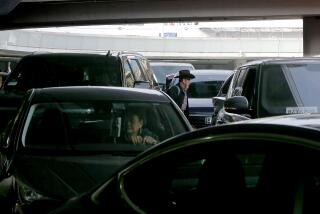Seismic Work at John Wayne Means 800 Fewer Parking Spots
- Share via
Hundreds of parking spots will be temporarily lost over the next year at John Wayne Airport as construction crews reinforce a pair of four-story parking structures as part of a $2.9-million, earthquake-safety project.
The work at the airport’s western parking garages, which began Monday, will advance in phases, with two floors at a time closed for 12 weeks. Parking will be permitted on the remaining floors, in the airport’s eastern garages and in an overflow lot just north of the airport.
The parking structures were designed in 1990 to withstand a major earthquake, airport manager Alan Murphy said. However, state and federal earthquake standards were changed after the 1994 Northridge earthquake.
“What we’re trying to do is maintain a facility that even after a major earthquake wouldn’t collapse and still would be able to operate,” Murphy said. “Obviously, we can’t do all the work at once.”
The work involves wrapping concrete columns with fiber. The first half of the work--to be completed in mid-October--affects parking for Alaska, American, Continental and Delta airline passengers. The second half, to be completed by next April, will affect America West, Aloha, Northwest, Southwest, United and US Airways passengers.
The airport’s bridges are to be seismically upgraded after the work on the western garages is completed. The eastern parking garages were retrofitted in 1999. The terminal, itself, needs minor work, Murphy said.
The parking crunch should hit heaviest during midweek, when the structures usually are full. There are 5,839 spaces along the sides of the terminal. About 800 spaces will be closed at a time.
Murphy said the seismic work is unrelated to problems that surfaced in one of the western parking structures before the terminal opened in 1990, part of a $310-million expansion of the airport.
Inspectors discovered hundreds of cracks in a garage, built by a contractor who was fired by supervisors after an eight-month delay and his failure to renew a required permit. The cracks--which appeared on ramps, floors and on columns supporting the four-level garage--weren’t considered a structural weakness at the time.
On the top deck of the garage, concrete had to be torn out and replaced because it was poured after it had partially hardened. Executives with Taylor Woodrow Inc., which built the structures, blamed the cracks on a faulty design. A second contractor completed the repair work.
Lawsuits filed against Taylor Woodrow and by Taylor Woodrow against the county were settled in 1993.
The county agreed to pay the company $9.6 million-- about one-third the amount Taylor Woodrow and its subcontractors wanted to complete the job.
More to Read
Sign up for Essential California
The most important California stories and recommendations in your inbox every morning.
You may occasionally receive promotional content from the Los Angeles Times.













